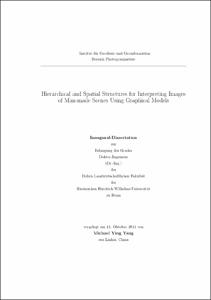Yang, Michael Ying: Hierarchical and Spatial Structures for Interpreting Images of Man-made Scenes Using Graphical Models. - Bonn, 2012. - Dissertation, Rheinische Friedrich-Wilhelms-Universität Bonn.
Online-Ausgabe in bonndoc: https://nbn-resolving.org/urn:nbn:de:hbz:5n-27658
Online-Ausgabe in bonndoc: https://nbn-resolving.org/urn:nbn:de:hbz:5n-27658
@phdthesis{handle:20.500.11811/5096,
urn: https://nbn-resolving.org/urn:nbn:de:hbz:5n-27658,
author = {{Michael Ying Yang}},
title = {Hierarchical and Spatial Structures for Interpreting Images of Man-made Scenes Using Graphical Models},
school = {Rheinische Friedrich-Wilhelms-Universität Bonn},
year = 2012,
month = feb,
note = {The task of semantic scene interpretation is to label the regions of an image and their relations into meaningful classes. Such task is a key ingredient to many computer vision applications, including object recognition, 3D reconstruction and robotic perception. It is challenging partially due to the ambiguities inherent to the image data. The images of man-made scenes, e. g. the building facade images, exhibit strong contextual dependencies in the form of the spatial and hierarchical structures. Modelling these structures is central for such interpretation task. Graphical models provide a consistent framework for the statistical modelling. Bayesian networks and random fields are two popular types of the graphical models, which are frequently used for capturing such contextual information. The motivation for our work comes from the belief that we can find a generic formulation for scene interpretation that having both the benefits from random fields and Bayesian networks. It should have clear semantic interpretability.
Therefore our key contribution is the development of a generic statistical graphical model for scene interpretation, which seamlessly integrates different types of the image features, and the spatial structural information and the hierarchical structural information defined over the multi-scale image segmentation. It unifies the ideas of existing approaches, e. g. conditional random field (CRF) and Bayesian network (BN), which has a clear statistical interpretation as the maximum a posteriori (MAP) estimate of a multi-class labelling problem. Given the graphical model structure, we derive the probability distribution of the model based on the factorization property implied in the model structure. The statistical model leads to an energy function that can be optimized approximately by either loopy belief propagation or graph cut based move making algorithm. The particular type of the features, the spatial structure, and the hierarchical structure however is not prescribed.
In the experiments, we concentrate on terrestrial man-made scenes as a specifically difficult problem. We demonstrate the application of the proposed graphical model on the task of multi-class classification of building facade image regions. The framework for scene interpretation allows for significantly better classification results than the standard classical local classification approach on man-made scenes by incorporating the spatial and hierarchical structures. We investigate the performance of the algorithms on a public dataset to show the relative importance of the information from the spatial structure and the hierarchical structure. As a baseline for the region classification, we use an efficient randomized decision forest classifier. Two specific models are derived from the proposed graphical model, namely the hierarchical CRF and the hierarchical mixed graphical model. We show that these two models produce better classification results than both the baseline region classifier and the flat CRF.},
url = {https://hdl.handle.net/20.500.11811/5096}
}
urn: https://nbn-resolving.org/urn:nbn:de:hbz:5n-27658,
author = {{Michael Ying Yang}},
title = {Hierarchical and Spatial Structures for Interpreting Images of Man-made Scenes Using Graphical Models},
school = {Rheinische Friedrich-Wilhelms-Universität Bonn},
year = 2012,
month = feb,
note = {The task of semantic scene interpretation is to label the regions of an image and their relations into meaningful classes. Such task is a key ingredient to many computer vision applications, including object recognition, 3D reconstruction and robotic perception. It is challenging partially due to the ambiguities inherent to the image data. The images of man-made scenes, e. g. the building facade images, exhibit strong contextual dependencies in the form of the spatial and hierarchical structures. Modelling these structures is central for such interpretation task. Graphical models provide a consistent framework for the statistical modelling. Bayesian networks and random fields are two popular types of the graphical models, which are frequently used for capturing such contextual information. The motivation for our work comes from the belief that we can find a generic formulation for scene interpretation that having both the benefits from random fields and Bayesian networks. It should have clear semantic interpretability.
Therefore our key contribution is the development of a generic statistical graphical model for scene interpretation, which seamlessly integrates different types of the image features, and the spatial structural information and the hierarchical structural information defined over the multi-scale image segmentation. It unifies the ideas of existing approaches, e. g. conditional random field (CRF) and Bayesian network (BN), which has a clear statistical interpretation as the maximum a posteriori (MAP) estimate of a multi-class labelling problem. Given the graphical model structure, we derive the probability distribution of the model based on the factorization property implied in the model structure. The statistical model leads to an energy function that can be optimized approximately by either loopy belief propagation or graph cut based move making algorithm. The particular type of the features, the spatial structure, and the hierarchical structure however is not prescribed.
In the experiments, we concentrate on terrestrial man-made scenes as a specifically difficult problem. We demonstrate the application of the proposed graphical model on the task of multi-class classification of building facade image regions. The framework for scene interpretation allows for significantly better classification results than the standard classical local classification approach on man-made scenes by incorporating the spatial and hierarchical structures. We investigate the performance of the algorithms on a public dataset to show the relative importance of the information from the spatial structure and the hierarchical structure. As a baseline for the region classification, we use an efficient randomized decision forest classifier. Two specific models are derived from the proposed graphical model, namely the hierarchical CRF and the hierarchical mixed graphical model. We show that these two models produce better classification results than both the baseline region classifier and the flat CRF.},
url = {https://hdl.handle.net/20.500.11811/5096}
}






